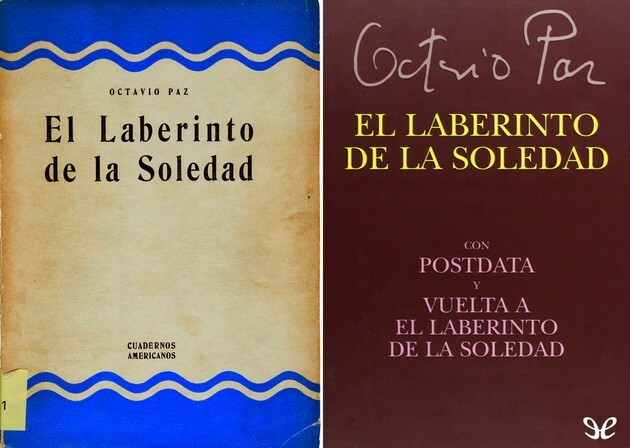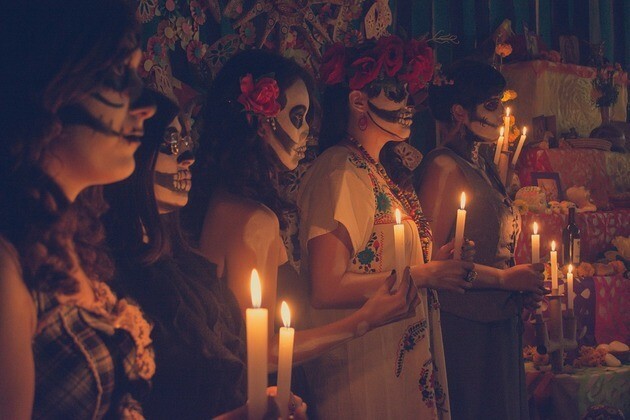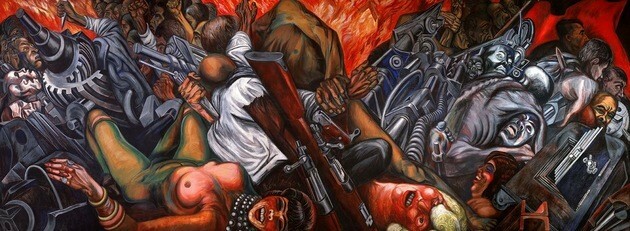The Labyrinth of Solitude, by Octavio Paz: summary and analysis of the book
In the book The Labyrinth of Solitude, the writer Octavio Paz reflects on the identity of Mexico and the cultural values that move the threads of his history. Written in the form of an essay, the density of its proposals has made it a referential text for all of Latin America. Therefore, in this article we offer a brief introduction to reading it: review, summary, analysis and brief biography of the author.
The twentieth century in Latin America opens with a question born of a barely incipient independence: does the Hispanic American identity exist, or what does it consist of? This question is also Octavio Paz's concern in this great essay called The Labyrinth of Solitude, where the author wonders about the identity of the Mexican being specifically. His main question will be "what makes Mexicans different?"
Structure of the book

Octavio Paz published The Labyrinth of Solitude for the first time in 1950. This, which was his first book of essays, underwent some modifications starting in 1959, when the second edition was released.
In its first edition, the book consisted of the first seven chapters, and the eighth was just the appendix. Since its second edition, the appendix "Our days" was incorporated as the eighth chapter.
Currently, all the chapters come together in a new appendix called "The dialectic of loneliness", a kind of synthesis of the ideas outlined throughout the text. The chapters are:
- The pachuco and other extremes
- Mexican masks
- All saints, day of the dead
- The children of La Malinche
- Conquest and colony
- From independence to revolution
- Mexican intelligence
- Our days
Appendix: The dialectic of loneliness
It seems that this book represented a great concern, not only for Octavio Paz but also for Mexican readers, since other sections were added in subsequent editions. Indeed, in 1969, Paz incorporated a section called “Postscript”, which consists of the following parts:
- Olympiad and Tlatelolco
- Development and other mirages
- Criticism of the pyramid
Later, an interview that Claude Fell did with Paz, published in the magazine Plural in 1975, and which was titled “Vuelta a The Labyrinth of Solitude”.
Summary of The Labyrinth of Solitude
Octavio Paz reflects on the identity and the Mexican nation in the middle of the 20th century, when Mexico was already facing the disappointments of the 1910 revolution. At that time, the world was also facing a radical capitalist transformation, the expansion of socialist ideology and the consequences of the Second World War, which ended in 1945.
The author goes to the literary genre of the essay, whose flexibility allows us to brood on a topic without the pretense of teaching or revealing universal laws. The essay shares a reflective path that is, in a way, the flow of one's own conscience. The essayist knows that identity, like a labyrinth, is a problem to be solved. For Mexico, it is the labyrinth of loneliness, the ultimate condition of being Mexican.
In the first four chapters of the book, Octavio Paz observes and analyzes migratory movements, symbols, manners and rituals of culture, all of them at the apex of a process of transformation. His main thesis will be about the conviction that being Mexican is based on loneliness, not as an existential thing, but as a collective imaginary, as a historical image.
To define the Mexican, Paz goes the other way: his first effort will be to look at the Mexican identity outside its borders. It will be later that Paz returns his gaze to the heart of Mexico itself, to analyze the social masks that lead to "ninguneo" as a collective practice. He will go through the symbols of the holidays and the cult of death, perceived as a revenge of life and, finally, It will reflect on the perspectives of a patriarchalism, based on the humiliation and symbolic violation of the mother.
Chapters 4 to 8 will review history as a freehand fabric, which will be the fabric that wraps this previously described culture: the conquest and the colony, the independence and the revolution, the Mexican intelligence and the contemporary days of Paz at that time, will give a discursive form to the solitude embodied in the imaginary collective.
Analysis of The Labyrinth of Solitude
Next, we will analyze in detail, chapter by chapter, each of the main approaches of Octavio Paz in The Labyrinth of Solitude.
The pachuco and other extremes (chapter 1)

It is interesting that Paz places his first approach to Mexican identity outside the borders of Mexico, in Los Angeles. By the 1950s, in this city there was a cultural group known as "pachucos", youth gangs, almost always Mexicans, with a manifest desire to be different, both to their origin and to the culture of reception. For peace, the pachuco tried to instill fear in search of self-humiliation, his will was to not be.
Thus, the pachuco is ideal for the image that will accompany the entire book: Mexican loneliness is born from the feeling of having been ripped off, says Paz. Therefore, the fundamental thesis will be that the history of Mexico is the search for that affiliation, the search for the link or the origin, from whose loss derives its essential loneliness.
Paz wonders: what makes Mexicans different? What differentiates them from Americans? The neighbor to the north seemed to Octavio Paz confident in the future; he fought for his ideals through perfecting the system and not through invention; he started from an optimism that denied reality, he liked police and fairy stories, he liked to understand and delight in humor. They were, at least until World War II, gullible.
For Paz, Mexicans contemplate the horror in their culture, they worship death; they are believers, but not credulous; They are not optimistic, but they believe in myths and legends; they contemplate and live sadness as an identity.
Mexican masks (chapter 2)
In this chapter, Octavio Paz reflects on Mexican attitudes of self-defense, resignation and irony that function as masks that hide reality. Thus, he establishes: the Mexican is closed. In this culture, opening up, showing yourself, is perceived as weakness and betrayal. Octavio Paz thinks that this is visible in expressions of language such as "no te rajes", a Mexican maxim.
To "crack" is to 'open up', it is to show what is inside, it is to be within reach of penetration, invasion, outrage, rape. For this reason, Paz relates the closed character of the Mexican with the prevailing machismo, since after all the woman is, then, an image of the slit that never closes. Woman is open by nature. Opening up is "selling oneself", says Paz.
Modesty is thus a mask that protects privacy. If the man is expected to be reserved, the woman is expected to be modest. The body "shows" being. The relationship with homosexuality and machismo in Mexico will give another clue: exercising it is nothing else than to "split", open oneself, but, despite this, it is valid to be the one who "cuts" the other, the one who "opens".
Everything is masks: simulation, self-concealment and dissimulation of the other, no-one and, finally, silence. They are defensive mechanisms, not offensive. That is the Mexican fight.
In this chapter, Paz also postulates that what is closed lives in Mexico as a love of form. Hence the ritualism and hence also the consolidation of the baroque, both literary and plastic, over other aesthetic paradigms.
All Saints, Day of the Dead (Chapter 3)

He should not be surprised that the Mexican likes public parties. These are channels of purification through chaos, rare moments when people can open up, "crack." The party allows expression, and, according to Paz, expressing yourself is breaking with yourself. The festival allows for a day to be exhibited what everyday culture prevents. That is the place of the day of the dead or the party of the scream.
The Mexican culture of the party is a cult of death that Octavio Paz observes as a symbol of revenge against life. Popular representations of death are approached by the author as symbols of the insignificance of human life.
The children of Malinche (chapter 4)

La Malinche appears in the middle acting as an interpreter between both languages.
Capitalism and its relationship with Mexico is one of Paz's concerns. According to the author, capitalism represents the dispossession of the human by reducing it to mere labor power. Capitalism breaks into society and transforms order and symbols into utility and profit.
If the peasant, says Paz, represents mystery and tradition, the worker is dissolved in what generic class, since he does not own his tools, the result of his work or his Profits. The worker plays only one function in the production chain. Therefore, his work becomes dehumanized. Similar thing happens with the technician. Capitalist society becomes efficient, but loses its way.
In the midst of this, the Mexican remains in the struggle with his past entities, whose sources are found in the conquest. This will be the place of the linguistic expression "Long live Mexico, sons of the chingada!"; But who is the Chingada? the author wonders.
This is a phrase used against others: the others, the foreigners, the bad Mexicans. Although chingar has a different meaning in each region of Latin America, it always has a violent connotation; always refers to a form of aggression.
Paz says that the chingada is, then, "the open mother, raped or mocked by force." She is Dona Malinche, Cortés's lover, so her children are the spawn of rape. If Malinche "has been sold", she has betrayed her people, the Mexican does not forgive her. She has broken with her mother, she has lost the bond.
This phrase is for Paz the sarcastic humiliation of the mother and the violent affirmation of the father. That is the cry of the revolution. For this reason, the revolution denies diversity and imposes man at the top. Once again closed, Mexicans live orphans and loneliness.
See also One Hundred Years of Solitude by Gabriel García Márquez.
Conquest and colony (chapter 5)

Faced with conquest and colonization, the Aztecs feel that the gods have abandoned them, they have left them orphaned. Spain, in those years, was not closed medieval Spain, but was open to universality due to the influence of the Renaissance. That is why Spain applies and adapts, but does not invent, according to Octavio Paz.
The Catholic Church, also of universal claim, offers the indigenous a filiation, a refuge and, ultimately, a role or role, even if it is the last in society. Hence, the Catholic religion has played a cohesive role.
In the same way that Spain does not invent, but applies and adapts, New Spanish art will not pretend originality. She will claim, yes, universality.
Sor Juana Inés de la Cruz will be an example of this. But she too, as the daughter of the colonial order imposed in Mexico, will live a double loneliness: the loneliness of women and of the intelligentsia. As is to be expected in the culture of masks, dissimulation and neglect, Sor Juana will end up keeping silence and abiding by the role that she has imposed on her.
From independence to revolution (chapter 6)

The decline of the colonial order brings with it an image of Latin America as a future to be realized and not as a tradition to continue.
But according to the author, the independence leaders put ideologies before them as a mask, since which, basically, do not propose a new order but the perpetuation of the previous order in the hands of the heirs. For this reason, Paz says, Mexican independence will be a class war and not a war with the metropolis; it will be an agrarian reform in the making.
The confusion that was generated in Mexico in those years allows the United States to take advantage of the situation to steal half of its territory, which mortally wounds the military caudillismo and hits Mexican morale. It is a crack, it is the earth violated, penetrated, cracked.
Later porfirismo will be heir to colonial feudalism. It is the imposition of a minority. Thus appears, once again in the history of Mexico, the simulation, hardly useful to break with the past, but incapable of creating a real order.
The Mexican revolution is the first and true revelation of being Mexican for Octavio Paz, because although he was born without program, his process was genuinely grassroots and long before the socialist revolutions of the century, beginning with the Russian.
Nevertheless, it would find its limits when arriving at the government. For this reason, trapped in its organic condition without an ideological program, it ends up adopting a liberal program, assimilating a socialist discourse and suffering the consequences of imperialism. What is born for the first time from an authenticity becomes, again, a disguise, a mask; in simulation and dissimulation. The revolution wants to return to the origin, and that will to return is the fruit of loneliness.
Mexican intelligence (chapter 7)

Octavio Paz addresses in this chapter the emergence and evolution of a new generation of intellectuals who accompanied the revolutionary process or who experienced transformation, not without contradictions. All kinds of artists and intellectuals emerged at the service of the revolution, who had to be trained in foreign areas to develop a role in the administration of the State. Some, identifying with the government, lost the critical spirit of the office.
Paz celebrates the educational policy developed by José Vasconcelos, secretary of education, who promoted important reforms and provided spaces for the development of arts of popular and national inspiration, such as muralism Mexican.
See also 5 keys to understanding the importance of Mexican muralism.
Author of The cosmic race, Vasconcelos sees Mexico and Latin America as a promise of the future for the world. However, Paz says that the claim of a socialist, progressive and antidogmatic education was contradicted by the liberal government program.
Paz highlights the value of the contribution of important Mexican intellectuals who made a difference and stood out, for which they constitute fundamental references, such as José Gaos and Alfonso Reyes, among much others.
Our days (chapter 8)

Reflecting on its current status, Octavio Paz recognizes that the revolution created the nation, gave it body and name, gave it an entity, but that, despite this, it was not able to create an order vital in which the answers that Mexicans have sought throughout their history could be found, especially from the moment they began to become aware of their specificity.
Analyzing his historical time leads him to scrutinize the limits and scope of the models of political, economic and social order that dominate the Western world by then, and that, in some way, affect the country's project: capitalism and socialism. Both systems, whether in discourse or in praxis, are insufficient to respond to the needs Mexican, as well as the realities of other nations, such as Latin American, Asian and African.
Perhaps in this labyrinth of Octavio Paz, in some way, a small breath of hope, of the possibility of being Mexican, of promise and of the future, which, in this case, demands the invention.
The review of the history, symbols, language, and rituals done by the author up to this point is nothing more than an effort. to find the paths that lead to the liberation of man, which is, after all, the purpose of all history human.
Brief biography of Octavio Paz

Octavio Paz Lozano (1914-1998) was born in Mexico City. He was a poet, essayist, and diplomat. His parents were Josefina Lozano and Octavio Paz Solórzano, who were an active fighter in the Mexican revolution that began in 1910. His grandfather, Ireneo Paz, was an intellectual and novelist. In his library, the young Octavio found a fascination with reading, especially poetry.
He was trained at the National Preparatory School in San Ildefonso and later studied at the Faculty of Law and Philosophy of the Autonomous University of Mexico (UNAM).
His first books of poetry used to have a great influence on Marxist thought, but little by little they transformed by the influence of the ideas of the surrealists as well as other movements literary.
In 1944 he received the Guggenheim Fellowship, for which he moved to the United States for a year. The following year, he began his career in the Mexican Foreign Service. Little by little, he will gain greater notoriety as a writer, until he becomes one of the most widely read authors in the Spanish-speaking world.
He received the Cervantes Prize in 1981 and the Nobel Prize in 1990. He dies in Coyoacán, Mexico.
Most important works of Octavio Paz
Poetry
- 1933.- Wild moon
- 1936.- Not pass!
- 1937.- Under your clear shadow and other poems about Spain
- 1949.- Parole
- 1954.- Seeds for a hymn
- 1999.- Figures and figurations
Test
- 1950.- The Labyrinth of Solitude
- 1956.- The bow and the lyre
- 1957.- Elm pears
- 1965.- Rotating signs and other trials
- 1966.- Varus remedies
- 1973.- The sign and the doodle
- 1982.- Sor Juana Inés de la Cruz or the traps of faith
- 1989.- Poetry, myth, revolution
- 1990.- The other voice. Poetry and end of the century
- 1993.- The double flame: love and eroticism

